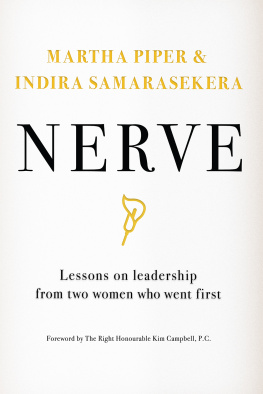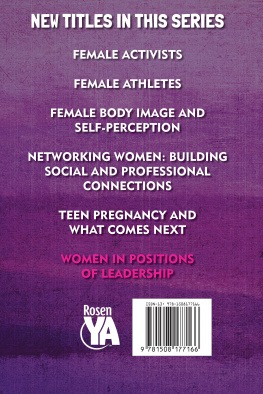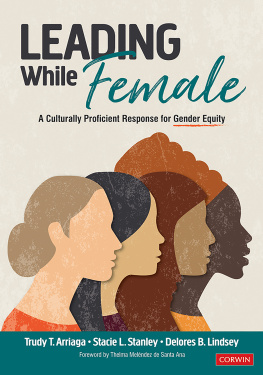To our grandchildren Charlotte, Henry, Elliott, Anila, Finnegan, Jacob, Benjamin, Priya.
Our hope is that you will live inspired livesand make a mark in the world.
Foreword
by The Right Honourable Kim Campbell, P.C.
Martha Piper and Indira Samarasekera describe themselves as two women who went first. Piper was the first, and to date only, woman to serve as president of the University of British Columbia (UBC), and Samarasekera was the first and only woman to serve as president of the University of Alberta (U of A), both institutions in the Big Five of Canadian research universities. Although my days at UBC as a student and lecturer long predated Pipers presidency, I knew her reputation as an outstanding leader. By the time she finished her second term at the helm of UBC, she was seen to have completed the process begun by her predecessor, David Strangway, in putting UBC on the map as one of the leading universities of the world.
In 2013, Indira Samarasekera approached me to speak to a group of U of A supporters about a new projectthe Peter Lougheed Leadership Initiative. Before long I would agree to come to U of A to create one part of that visionthe Peter Lougheed Leadership College. As she describes in this book, that initiative was a perfect illustration of the difficulty of leading in a university. One of my colleagues at U of A described being a department chair in a university as being given a gun with no bullets. The description of a university faculty as a collection of independent contractors, brought together by a shared grievance over parking accurately reflects the reluctance of university faculties to be led. As a woman who shares membership in the Went First club as Canadas Minister of Justice and Attorney General, Minister of National Defence and Prime Minister, I want to emphasize that no matter how difficult and challenging political leadership is, it is an extraordinary achievement that these two women were not only named presidents of their respective institutions but also had the nerve to stay the course and that they succeeded beyond their greatest critics wildest fears!
Nerve is often used for a brand of courage to which the woman in question is not deemed to be entitled as in, she has a lot of nerve. Nerve is not just courage per se, but, specifically, the courage to do somethingthus, I just didnt have the nerve to do X. The two authors describe the unwillingness of many women to take on leadership roles as their lack of nerve. Women feel the need to exceed the requirements of any job for which they might be considered, a frame of mind that is not often found in men, whose nerve has been described as the masculine propensity for positive illusion. I think an important factor in explaining the frequent lack of nerve in women is their understanding that, for them, failure will not necessarily be just a part of a process of learning and growing in their leadership role but could just as likely end it.
A number of years ago I participated in a program with most of the 10 women who had led provincial and territorial governments in Canada. The program was entitled No Second Chances, and I was surprised at the number of participants for whom the leadership experience was unhappy and demoralizing. Often, their chance to lead came when their parties were in bad shape, and the electoral prospects were dim. If they succeeded, their male colleagues worked to edge them out since the top job was now attractive. If they were unable to turn the party fortunes around, the result was put primarily on their shoulders. The risks of leading are greater for women than for men. That being said, I have no regrets about my own experience. My observations of national leaders such as Jacinda Ardern of New Zealand and Germanys Angela Merkel are that they love what they do. They are among the most respected leaders of either sex in the world today.
The late UC Berkeley philosopher Joseph Tussman liked to say, The unit of human understanding is the story. In exploring their routes to leadership, Piper and Samarasekera tell the stories of their lives. Their decision as friends and colleagues to do this together is much to their readers benefit as the parallel storytelling allows us to take note of the differences and similarities in their paths. As skilled teachers, the authors reflect on what they describe and draw out the lessons to be learned from their leadership experiences. I found that this structure encouraged me to compare my own life as a female first. The observations of Piper and Samarasekera form an excellent framework for discussion and personal reflection for anyone, man or woman, who is interested in women and leadership. There is also a good dose of solid research incorporated into the discussion. One of the major developments in the understanding of leadership since my own youthful days is the growing body of scholarly research on why gender barriers occur and also on the skills and competences that women bring to leadership roles. Far from confirming the stereotypical assumption that men are more natural leaders, research shows that women often exceed men in the skills required to lead successfully.
Both Piper and Samarasekera describe their post-presidential experiences sitting on corporate boards of directors. Numerous studies confirm the wisdom of these appointmentsto the extent that many jurisdictions require gender diversity on the boards of publicly traded companies. Support comes in the form of studies such as one by Credit Suisse (not an organization one would think of as excessively socially progressive) that demonstrated that companies that include women in senior management and on their boards of directors are more profitable than ones that do not. The question is no longer, How can we justify to our shareholders putting you (female) on the board when our concern must be for the bottom line? Now the question becomes, Knowing what you do about the value of women in management and on boards of directors, how do you justify to your shareholders that you do not have any?
Finally, Nerve is a generous book because the authors share some of the missteps that almost derailed them. My experience is that when women speak honestly of their failings, this becomes an excuse for those who do not accept their presence in leadership roles to pile on rather than allow an exploration of how to learn from mistakes.








